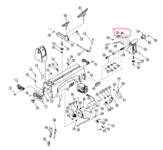qquake
Member
Any idea what is causing the chatter? It's only on the right (tailstock) side. It quiets and gets smoother towards the left (headstock) side. It's a fresh edge on my carbide chisel. The blank is a label cast from Wooden Quill. I don't know what kind of resin it is. Each side looks the same, but you can feel that the left side is smoother than the right side. It's on an Ultra-Shear mandrel system, turning at about 2,000 rpm. I'm perplexed.


Personal Twist Nursing Stethoscope Pen Kit and Blank Combo – Blue
Honor nurses with a great pen and blank combination package Pen Blank: Blue Nursing Stethoscope Heart – EKG Image – Cast on Personal Twist Tube with the phrase: “Doctor’s Diagnose” “Nurses Cure” Ch…
store.thewoodenquill.com





















